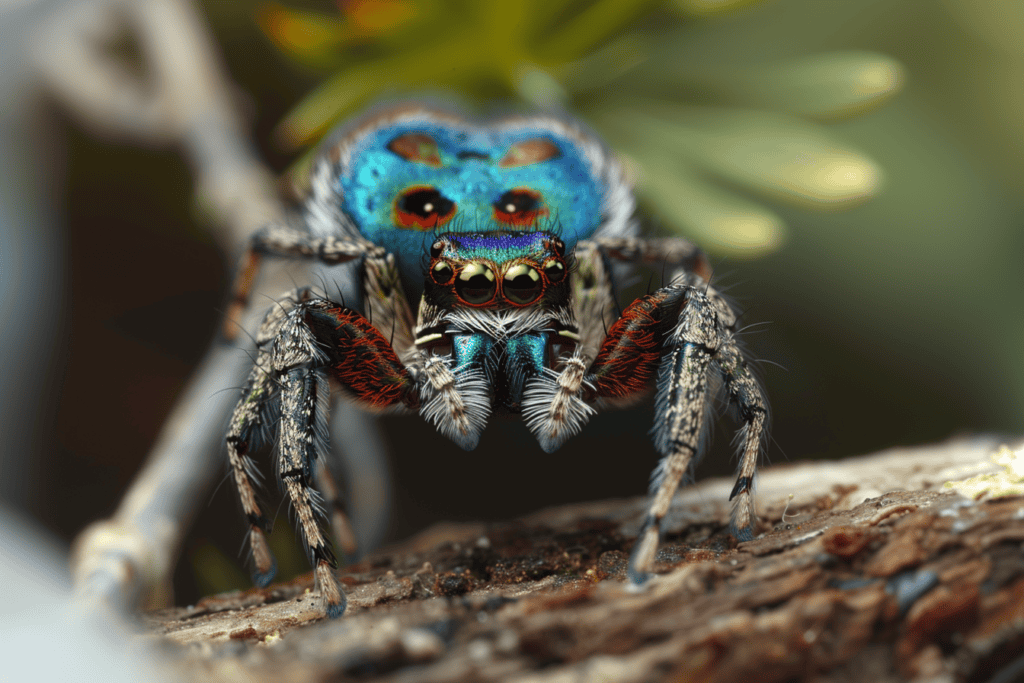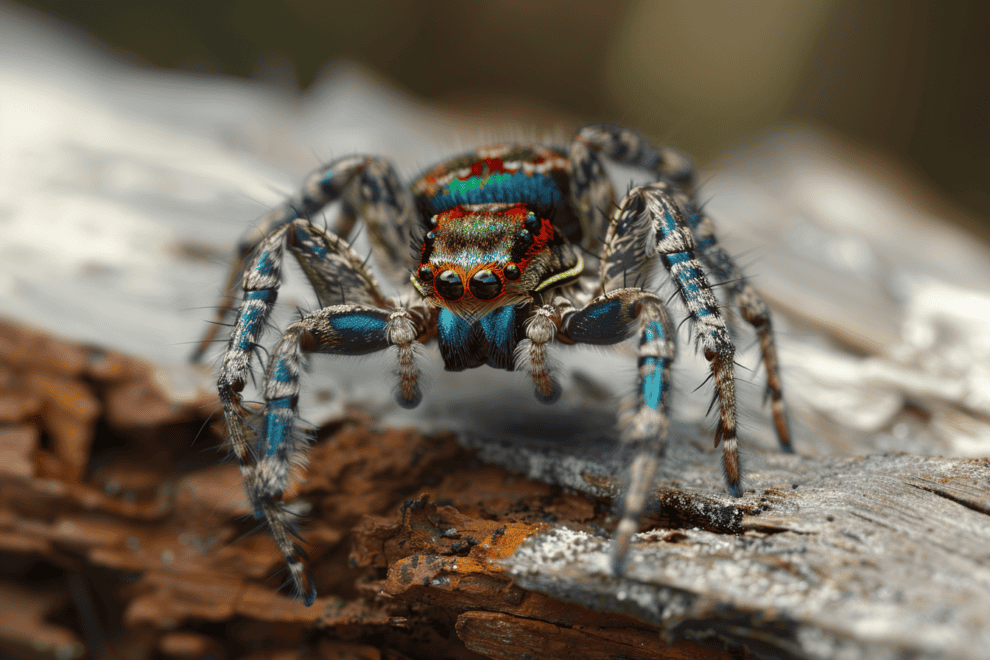Peacock spiders are fascinating creatures that have captured the imagination of scientists and nature enthusiasts alike.
These tiny arachnids, found exclusively in Australia, are known for their colorful and intricate courtship displays.
In fact, they are often referred to as “dancing jewels” due to their vibrant colors and intricate movements.

Male peacock spiders use their brightly colored abdomens to attract females, performing elaborate dances that involve waving their legs and moving their bodies in intricate patterns.
The courtship displays are not only visually stunning but also serve as a way for the male spider to showcase his fitness and genetic quality to potential mates.
Despite their small size, peacock spiders have captured the attention of scientists and the public alike.
Their unique courtship displays have been studied extensively, with researchers uncovering new insights into the evolution of mating behavior in spiders.
Additionally, their colorful appearance and captivating dances have made them a popular subject for nature documentaries and social media posts alike.
The Dazzling World of Peacock Spiders
Meet the Peacock Spider
Peacock spiders are a fascinating species of arachnids that are known for their unique courtship displays.
These tiny spiders, which measure between 2.5 to 6 millimeters, are native to Australia and are part of the Maratus genus.
Peacock spiders are named for their colorful and iridescent markings, which resemble those of a peacock.
These markings are used by male spiders to attract potential mates during their elaborate courtship displays. The males will raise their legs, wave their colorful abdomens, and dance in intricate patterns to impress the females.
A Spectrum of Species
There are currently over 80 known species of peacock spiders, each with their own unique colors and patterns.
Recently, seven new species of peacock spiders were discovered in Australia, bringing the total number of known species to 84.
Some of the most striking species of peacock spiders include the Maratus splendens, which has vibrant blue and red markings, and the Maratus personatus, which has a striking mask-like pattern on its abdomen.
Peacock spiders are not only visually stunning, but they also play an important role in their ecosystems. These spiders are predators that help to control the populations of other insects and arachnids.
The Art of Attraction

Courtship Dance Explained
Peacock spiders are known for their vibrant colors and intricate courtship dances.
The males perform these dances to attract females and show off their fitness as a mate.
The courtship dance is a crucial part of the mating display, and it is among the most complex and beautiful displays in the animal kingdom.
During the dance, the male spider raises his abdomen, exposing his colorful “fan,” and begins to wave his legs and move his body in a rhythmic pattern.
The dance is accompanied by vibrations that the male creates by tapping his legs on the ground.
These vibrations are an essential part of the dance, and they help to attract the female’s attention.
Vibrant Visuals and Vibrations
The male peacock spider’s courtship dance is a visual and auditory spectacle.
The male’s colorful fan and intricate movements are mesmerizing to watch, and the vibrations he creates add an extra layer of sensory stimulation.
The female spider is drawn to these displays, and she uses them to evaluate the male’s fitness as a mate.
The vibrations created by the male spider are essential because they help to communicate with the female spider.
The vibrations are transmitted through the ground, and the female spider can sense them using specialized sensory organs on her legs.
These vibrations help the female to locate the male and evaluate his fitness as a mate.
Behind the Scenes – Capturing These Tiny Spiders On Camera

The world of peacock spiders is a fascinating one. Scientists and researchers have been studying these tiny creatures for years, trying to unravel the mysteries of their unique dance moves and colorful bodies.
Jürgen Otto, a biologist and photographer, has been at the forefront of this research, capturing stunning footage of peacock spiders in action and sharing it on his YouTube channel.
To better understand these spiders, researchers have been studying their behavior in the wild.
They have observed that male peacock spiders use their colorful bodies and intricate dance moves to attract females.
These dances are incredibly complex and require a great deal of skill and coordination. Scientists believe that these dances may have evolved over time as a way for males to show off their genetic fitness to potential mates.
Capturing the intricate dance moves of peacock spiders on film is no easy feat. Jürgen Otto has spent countless hours in the field, patiently waiting for the perfect shot.
He uses high-speed cameras to capture the spiders in action, allowing him to slow down the footage and study the movements in detail.
Otto’s work has been instrumental in helping scientists better understand the behavior of peacock spiders.
His footage has revealed new insights into the spiders’ courtship rituals and has helped to shed light on the complexity and diversity of the natural world.
Conservation and Curiosity

Peacock spiders are fascinating creatures that have captured the attention of many people around the world.
These tiny invertebrates are found only in Western Australia, and their unique courtship dances have made them a subject of curiosity for many entomologists and nature enthusiasts.
Conservation efforts are underway to protect these tiny dancers and their habitats.
As with many species, habitat loss and climate change are major threats to their survival.
Fortunately, Western Australia has a number of protected areas where these spiders can thrive, and conservationists are working to expand these areas.
In addition to protecting their habitats, researchers are also studying peacock spiders to learn more about their behavior and biology.
This curiosity-driven research helps us to better understand the natural world and the role that these creatures play in their ecosystems.
Did you know that there are over 100 species of peacock spiders?
Each species has its own unique courtship dance, and researchers are still discovering new species and learning more about their behavior.
Peacock spiders may be small, but they are an important part of the natural world.
By protecting their habitats and studying their behavior, we can learn more about these fascinating creatures and the ecosystems that they inhabit.
Frequently Asked Questions

How do peacock spiders use their colorful display during mating rituals?
Peacock spiders are known for their vibrant and iridescent patterns displayed during their courtship dance.
The males use their colorful display to attract females.
The dance involves a series of movements, including lifting their legs and waving them in the air, while displaying their colorful abdomen.
The patterns on their abdomen are unique to each species and are thought to play a crucial role in attracting mates.
The male’s display is so captivating that it has been compared to a jewel on display.
What habitats are peacock spiders found in, and how does this affect their behavior?
Peacock spiders are found in a variety of habitats, including forests, woodlands, and heathlands, primarily in Australia.
Their behavior is influenced by their habitat, and they have adapted to thrive in different environments.
For example, some species are found in sandy habitats and have evolved to blend in with their surroundings, while others are found in leaf litter and have adapted to move quickly through the dense foliage.
Can you explain the significance of the peacock spider’s dance to its survival?
The peacock spider’s dance is essential to its survival because it is how males attract females for mating.
A successful courtship dance means that the female will mate with the male, ensuring the survival of the species.
The dance is also a way for males to show off their strength and agility, making them more attractive to potential mates.
What are the main predators of peacock spiders, and how do they protect themselves?
Peacock spiders have a few natural predators, including birds, reptiles, and larger spiders.
To protect themselves, peacock spiders have evolved to be agile and quick, making them difficult to catch.
They also have venomous fangs, which they use to defend themselves from predators.
How do scientists study the intricate patterns on peacock spiders?
Scientists study the intricate patterns on peacock spiders using high-resolution microscopes and imaging techniques.
They can also analyze the spiders’ DNA to understand the genetic basis for the patterns.
By studying the patterns, scientists can learn more about the spiders’ evolution and behavior.
What role do peacock spiders play in their ecosystems?
Peacock spiders play an essential role in their ecosystems. They are predators of insects and other small arthropods. They also serve as prey for larger predators, contributing to the food web.
Their unique and colorful appearance makes them a popular subject for scientific research and a source of fascination for nature enthusiasts.

